Running SOTA AI-based Weather Forecasting models on AMD Instinct#
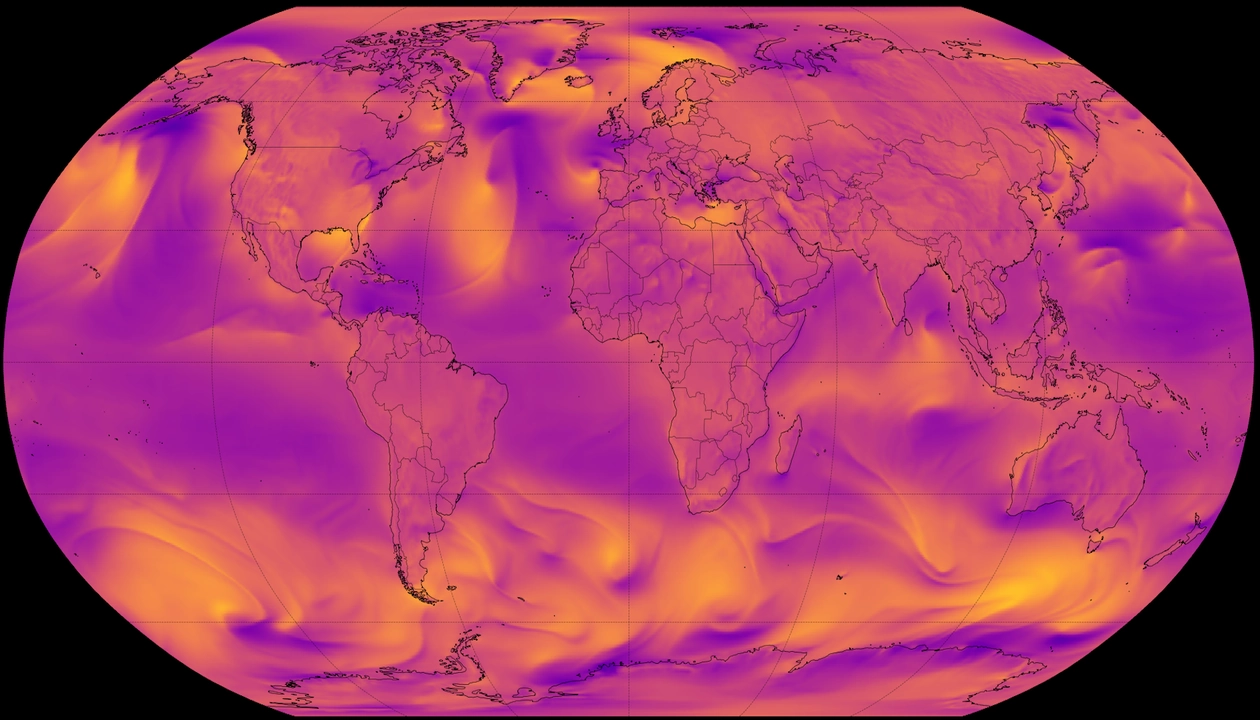
Weather Forecasting is a complex scientific problem where immense progress has been made through the Numerical Weather Prediction (NWP) approach using computational fluid dynamics-based models. Forecasting is usually done in three stages: a data assimilation stage where all available data streams at the time \(t\) (sometimes previous times can be used to improve this estimate) are used to estimate the current 3D state of the atmosphere \( S_{t}\) (surface and atmosphere), as parameterized by a number of variables at the current time \( t\), a forecasting stage where the state \(\hat{S}_{t + \delta t}\) for a later time \( t+ \delta t\) (i.e., all the variables at this later time) are forecasted, and a downstream stage where the forecasted state at time \(t + \delta t\) is used to estimate weather variables at more specific times and locations.
In the past few years, there has been a quiet revolution with the development of a slew of AI models that learn spatio-temporal weather patterns from about forty years of well-curated weather data. While AI models are being developed as alternatives to the NWP methods for each of the stages described above, they have been most successful when applied to the second stage of forecasting. Such AI models have been shown to perform at similar levels—or slightly better—on many metrics compared to NWP, but at a small fraction of the computational cost. The state-of-the-art (SOTA) models tend to be deep neural network models and leverage data products like ERA5 [1] built from observations, and NWP methods. Such models include deterministic models like Pangu-Weather [2] developed by Huawei, ensemble models like GenCast [3] developed by Google DeepMind, and foundation models tuned on weather data like Aurora [4] developed by Microsoft Research. All these models perform quite well on commonly studied metrics, but investigations continue on the reliability of AI models in more diverse (and extreme) conditions. These model architectures are also available as open-source code from the developers on GitHub (e.g. Pangu-Weather, GenCast, Aurora repositories). Weights for such models trained by their developers are also currently available as checkpoints, but under non-commercial licenses. In this blog post, we show how to run these models on AMD Instinct MI300X GPUs.
Prerequisites#
To follow along executing the code, you will need:
computer with one or more AMD Instinct MI300X GPUs
Docker
credentials on Climate Data Server for data to be used as input
Most mainstream deep learning models use one of the popular ML frameworks such as JAX or PyTorch to perform the computations efficiently on accelerators. To do this on AMD GPUs, we need versions of such frameworks compatible with ROCm and such compatible frameworks can be installed in a variety of ways described on the ROCm website. In our case, Gencast uses the JAX framework, while Aurora uses the PyTorch framework. We will use the pre-built Docker images and install the dependencies on top of that. For GenCast and Pangu-Weather, we will follow the ROCm Jax page [5] and for Aurora we will create an image based on the ROCm PyTorch image as described here. We install GenCast and Pangu-Weather on the JAX based image, and Aurora on the py-torch based image. Then we install a wrapper ai-models [6], and the required plugins from the European Commission for Medium Range Weather Forecasting (ECMWF). The wrapper helps download the required input data and format it appropriately for the deep learning model involved. For Pangu-Weather, which uses an ONNX backend, we will apply a patch to ensure the ai-models framework provides execution capabilities for ROCm based executions rather than hard-coding a CUDA based execution provider. The code to build these images is provided at our github repository.
To install everything, we clone the repository and build the Docker images corresponding to JAX and PyTorch from the dockerfiles to containerize the applications.
git clone https://github.com/silogen/ai-samples
cd ai4sciences/ai-weather-forecasting
docker build -t jaxweather:latest -f jax.dockerfile .
docker build -t pytorchweather:latest -f pytorch.dockerfile .
Downloading Input Data#
As mentioned, the models will require input data which will be downloaded on the fly by ai-models. In order to download the data from the Climate Data Store (CDS), we need an account. Please follow the instructions on the climate data store setup page to get the URL and key, which must be provided to the model. When we run the docker image, we will pass environmental variables stored in the file weather-forecasting/env_file. Let us edit the file, providing values to the variables. The CDSAPI_URL variable already points to the URL for CDS found in the previous step. Now we can edit the file to provide values for the key CDSAPI_KEY. Therefore the env_file should look like:
CDSAPI_URL=https://cds.climate.copernicus.eu/api
CDSAPI_KEY=your_key
#EARTHKIT_DATA_USER_CACHE_DIRECTORY=location_for_cache_download
#HIP_VISIBLE_DEVICES=0,1
The other variables are commented out and can be left as such. But if we want to use them, we can uncomment them and provide the appropriate values. By default, the input data will be stored in /tmp/earthkit-data-root, but if we want to store these at some other location accessible to Docker, its location can be changed to that of the environment variable EARTHKIT_DATA_USER_CACHE_DIRECTORY. Finally, if we have more than one GPU in our system, but only want to use a certain subset, we can do that in a few ways. First, we can pass the environment variable HIP_VISIBLE_DEVICES to specify the GPU ID, such as 0 or 0,1. Alternatively, we may run the Docker container only giving access to certain GPUs following the ROCm documentation pages. Here, we use the environment variable.
The installation is now complete and we can start running the models. We will begin by spinning up the Docker container and starting a bash shell there.”
docker run -it --rm \
--cap-add=SYS_PTRACE \
--env-file=env_file \
--security-opt seccomp=unconfined \
--device=/dev/kfd \
--device=/dev/dri \
--cap-add=SYS_RAWIO \
--device=/dev/mem \
--group-add video \
--network host \
--name jaxrocm \
jaxweather:latest bash
which runs the jaxweather image in a container named jaxrocm and runs the bash command dropping us onto the shell.
We can quickly check that the environment variables we set in the file are sourced, by echoing them:
echo $CDSAPI_URL
In the following, we describe how to run inference on both the GenCast and the Pangu-Weather models. For convenience, the following code snippets can also be found in the file code/jax_script.sh available in the repository.
We can see that using the –models option gives us the list of available models currently installed
ai-models --help
While we will not explore all the options here, let us look at a couple:
ai-models --models
--- Output---
gencast
gencast-0.25
gencast-0.25-Oper
gencast-1.0
gencast-1.0-Mini
panguweather
gives us the list of available models. This one should show a few flavours of GenCast and Pangu-Weather.
The outputs we get from ai-models are stored in .grib files and can be opened as lists of xarray.dataset objects using cfgrib as shown in the following code block.
# assume path to output is `output.grib`
import cfgrib
import xarray as xr
dss = cfgrib.open_datasets('output.grib')
# len(dss) = 4 # dss is a list of 4 dataset objects.
Pangu-Weather#
Pangu-Weather is an AI model in this area based on transformers, developed by Huawei and described in this paper The code is available in this repository. First, we can check what variables are predicted.
ai-models --fields panguweather
--- Output ---
Grid: [0.25, 0.25]
Area: [90, 0, -90, 360]
Pressure levels:
Levels: [1000, 925, 850, 700, 600, 500, 400, 300, 250, 200, 150, 100, 50]
Params: ['z', 'q', 't', 'u', 'v']
Single levels:
Params: ['msl', '10u', '10v', '2t']
The grid and area outputs show that the 3D atmospheric state is defined on a latitude, longitude grid of \(0.25\ \rm{degree}\) resolution, which corresponds to a distance of \(28\ \rm{Km}\), and thirteen pressure levels in the atmosphere.
We can see the variables predicted by the model: Geopotential (\(z\)), Specific Humidity (\(q\)), Temperature (\(t\)), Eastward Component of the wind (\(u\)) and the Northward component of the wind (\(v\)) at each of the 13 pressure levels, while it predicts the mean sea level pressure (\(msl\)), the Eastward Component of the wind (\(10u\)) and the Northward component of the wind (\(10v\)) at 10m above the surface of the earth, and the temperature at 2m above the surface of the earth (\(t2\)).
As input, the model uses two states of the atmosphere \(S_t\) at times \(t\) and \(t - \delta t.\) It uses a transformer based model to predict the state \(S_{t+\delta t}\) where \(\delta t = 6\ \rm{hours}\). Further, one can use this to predict at longer lead times of \(N \delta t\) for integer \(N\) using autoregression.
MODEL_NAME=panguweather
mkdir -p predictions assets logs
ai-models --download-assets \
--assets "assets/$MODEL_NAME" \
--input=cds \
--date=20240101 \
--time=0000 \
--lead-time=24 \
--path="predictions/$MODEL_NAME.grib" \
$MODEL_NAME
We can visualize this using the command:
python3 grib_visualizer.py --input predictions/$MODEL_NAME.grib
This command will generate plots in ./output directory.
GenCast#
GenCast is an AI model developed by Google DeepMind and described in the paper [2] and available from the repository.
Again, we can examine the fields that would be predicted. For example, to find the ones predicted by a GenCast model named as gencast-0.25 above, we do:
ai-models --fields gencast-0.25
--- Output ---
Grid: [0.25, 0.25]
Area: [90, 0, -90, 360]
Pressure levels:
Levels: [50, 100, 150, 200, 250, 300, 400, 500, 600, 700, 850, 925, 1000]
Params: ['t', 'z', 'u', 'v', 'w', 'q']
Single levels:
Params: ['lsm', '2t', 'sst', 'msl', '10u', '10v', 'tp', 'z']
Thus, we see that the model has an identical latitude-longitude and pressure grid, and predicts the variables: Temperature (\(t\)), Geopotential (\(z\)), Eastward Component of the wind (\(u\)), the Northward component of the wind (\(v\)), the vertical velocity \(w\), and Specific Humidity (\(q\)) at each of the 13 pressure levels, while it predicts the temperature at 2m above the surface of the earth (\(2t\)), Sea surface temperature (\(sst\)), mean sea level pressure (\(msl\)), the Eastward Component of the wind (\(10u\)) and the Northward component of the wind (\(10v\)) at 10m above the surface of the earth, the total precipitation (\(tp\)). The land-sea-mask (\(lsm\)) which is static and the geopotential at the surface of the earth (\(z\)) are used as inputs along with latitude, longitude, local time of day, and elapsed year progress.
As input, the model uses two states of the atmosphere \(S_t\) at times \(t\) and \(t - \delta t.\) It uses a diffusion model to generate samples of the probability distribution \(P\left(S_{t+\delta t}\vert S_{t}, S_{t-\delta t}, M\right)\) where \(\delta t = 12\ \rm{hours}\). This allows uncertainty quantification on the predictions. It is possible to do autoregressive predictions at lead times of \(N \delta t\) for integer \(N\).
In this case, the ai-models package will use a set of weights provided by Google at 0.25 degree resolution trained on ERA5 data. These weights are licensed under the Creative Commons Attribution-NonCommercial-ShareAlike 4.0 International (CC BY-NC-SA 4.0) by Google. It will also use the Google provided GenCast code to run the checkpoint. Since this code uses a JAX backend which reserves a chunk of video memory it is nice to set a couple of XLA parameters appropriate for MI300X, but things will still run without these set. If we were to use a GPU with a lower or higher memory, these may need to be modified. Here we set these in the docker image by running set_XLA_params.sh.
source set_XLA_params.sh
We can go ahead and run GenCast:
The models need to normalize the data to its statistics, this is
downloaded using the --download-assets flag. Further, runs can skip this flag.
MODEL_NAME=gencast-0.25
mkdir -p predictions assets logs
ai-models --download-assets \
--assets "assets/$MODEL_NAME" \
--input=cds \
--date=20240101 \
--time=0000 \
--lead-time=240 \
--path="predictions/$MODEL_NAME.grib" \
$MODEL_NAME > logs/$MODEL_NAME.log 2>&1 &
To visualize the grib outputs, we can run this code
python3 grib_visualizer.py --input predictions/$MODEL_NAME.grib
This will produce animations for variables at different pressure levels as well as surface levels in the ./output directory.
In calling GenCast via ai-models we did not specify the number of samples, which is 1 by default. This can be done through the option --num-ensemble-members=. Note that GenCast does this computation distributed across GPUs available, and it is required that the number of ensembles is a multiple of the number of GPUs available.
Aurora#
Aurora is a foundation model for the Earth System, developed by Microsoft Research described in this paper. The model has been trained on several earth datasets at different resolutions. This results in a model that can be further fine-tuned on a new dataset or with new variables. The code is available at the repository To run predictions using provided checkpoints, we use the PyTorch image:
docker build -t torchweather:latest -f pytorch.dockerfile .
docker run -it --rm \
--cap-add=SYS_PTRACE \
--env-file=env_file \
--security-opt seccomp=unconfined \
--device=/dev/kfd \
--device=/dev/dri \
--cap-add=SYS_RAWIO \
--device=/dev/mem \
--group-add video \
--network host \
--name torchrocm \
torchweather:latest bash
Aurora
aurora-0.1-finetuned
aurora-2.5-finetuned
aurora-2.5-pretrained
ai-models --fields $MODEL_NAME
/opt/conda/envs/py_3.12/lib/python3.12/site-packages/redis/connection.py:77: UserWarning: redis-py works best with hiredis. Please consider installing
warnings.warn(msg)
Grid: [0.1, 0.1]
Area: [90, 0, -90, 359.9]
Pressure levels:
Levels: (1000, 925, 850, 700, 600, 500, 400, 300, 250, 200, 150, 100, 50)
Params: ('z', 'u', 'v', 't', 'q')
Single levels:
Params: ('2t', '10u', '10v', 'msl')
Then, we have an ai-models wrapper to use as in previous cases. The code that we display here is also code/torch_script.sh file in the cloned repository. So to run the aurora models, we can do
MODEL_NAME=aurora
mkdir -p predictions assets logs
ai-models --download-assets \
--assets "assets/$MODEL_NAME" \
--input=cds \
--date=20240101 \
--time=0000 \
--lead-time=24 \
--path="predictions/$MODEL_NAME.grib" \
$MODEL_NAME > logs/$MODEL_NAME.log 2>&1 &
Again, we can visualize the outputs by running the following code:
python3 grib_visualizer.py --input predictions/$MODEL_NAME.grib
This will produce animations for variables at different pressure levels as well as surface levels in the ./output directory.
Visualizing the Model Outputs#
The outputs for the models can be opened using cfgrib as described above. If we have run the visualization commands above, then a directory called ./outputs has been created with some gifs for the surface variables, and directories for each pressure level which contain gifs for the variables at each pressure level.
outputs $ ls aurora
level_100 level_1000 level_150 level_200 level_250 level_300 level_400 level_50 level_500 level_600 level_700 level_850 level_925 msl.gif t2m.gif u10.gif v10.gif
outputs $ ls aurora/level_100
q.gif t.gif u.gif v.gif z.gif
where each level directory has the atmospheric variables corresponding to the isobaric level.
We will only go through visualizing a couple of the variables here. First, let us look at the Geopotential z at an isobar of 500 hPa. Animations of the 10-day forecast of the Geopotential following January 1, 2024 according to models Pangu-Weather, GenCast and Aurora created using the code blocks above are shown in Figures 1, 2 and 3 respectively. The Geopotential is the work done in moving a unit mass from the mean sea level to the location (lat, long, pressure surface) and for small geometric altitudes (the distance from the sea level as would be measured by a tape) \(h\) is \(g_{surface} \times h\) to a very good approximation, where \( g_{surface}\) is the gravitational acceleration due to the earth at the mean sea level, approximately \( 9.8\ \rm{ms}^{-2}\). Thus, we can see the isobar is a crinkled surface in geometric altitude. From the plot, it appears that this surface has a median altitude of \(53\times 10^{3} /g_{surface}\ \approx\ 5.4 Km\) in the mid latitude regions, whereas the poles have approximately \( 10 \%\) lower values and the equatorial region has \( 10 \%\) higher values. The average geometric altitude of the isobaric level at a fixed pressure of \( 500\) hPa down from about \(1013.25\) h Pa at sea level is about 5.5 Km, which is a good match to the median stated above. We also expect the equatorial regions to typically have higher geopotentials than the poles (as shown in the figures) due to three effects: the acceleration due to the earth’s rotation, the (related) equatorial bulge of the earth, and because temperatures are higher in the equatorial regions. It is the last effect that dominates, as at higher temperatures the pressure falls less rapidly with altitude. Thus the altitude at which a certain pressure (lower than the mean sea level pressure) is reached is higher in regions of high temperature. Additionally, looking at the GIFs, we see some blobs of blue break off from the blue patch at high latitudes in the North and South. At these points of time, these are troughs of the geopotential, or equivalently the height. If instead, we imagined looking at surfaces of constant geometric altitude, these would be locations where the pressure was equal to the average (lower) pressure at higher altitudes. Thus, these troughs are related to lower pressure regions.

Figure 1: The Geopotential Z at an isobar of 500 hPa above the earth’s surface as predicted for \(10\ \rm{days}\) using the Pangu-Weather model with starting date of 01/01/2024.
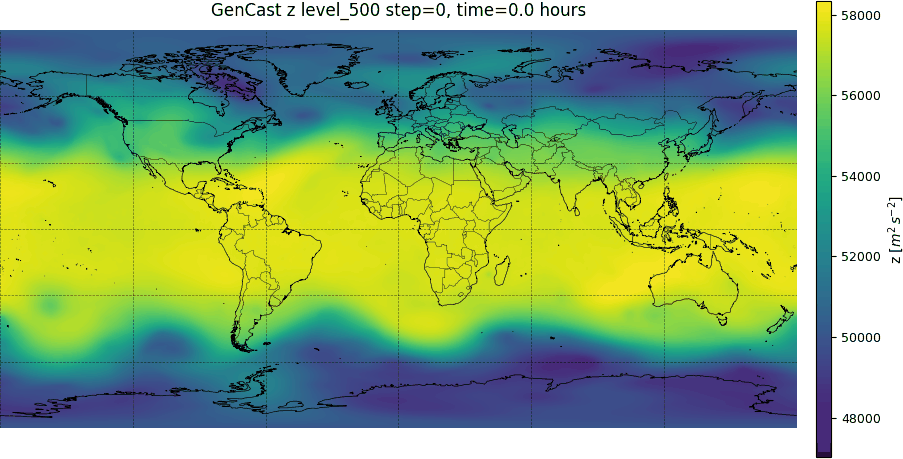
Figure 2: The Geopotential Z at an isobar of 500 hPa above the earth’s surface as predicted for \(10\ \rm{days}\) using the GenCast model with starting date of 01/01/2024.
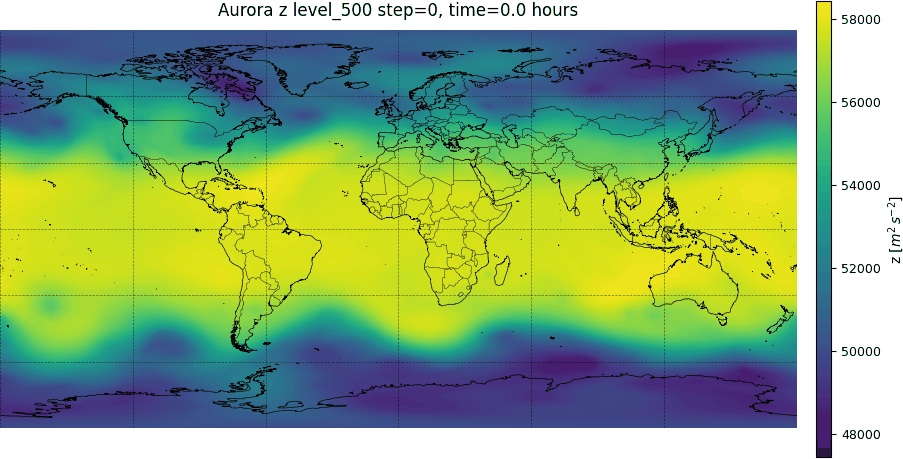
Figure 3: The Geopotential Z at an isobar of 500 hPa above the earth’s surface as predicted for \(10\ \rm{days}\) using the Aurora model with starting date of 01/01/2024.
Finally, we can look at similar animations of the temperature at two meters above the surface of the earth forecast using Pangu-Weather, GenCast, and Aurora and shown in Figures 4, 5 and 6 respectively. Since this relates to the first 10 days of January we see from the color scale (Temperature in Kelvin), that it is colder in the Northern Hemisphere than in the Southern Hemisphere, while the Tropical regions are the warmest. We also notice that the temperature rapidly increases during the day and cools off during the night in the inland parts of the earth (most easily seen in Africa, South America and Australia), while the temperature in the oceans is much more stable due to larger heat capacity. The effect is not as easily visible in the Northern Hemisphere due to overall lower temperatures during winter.
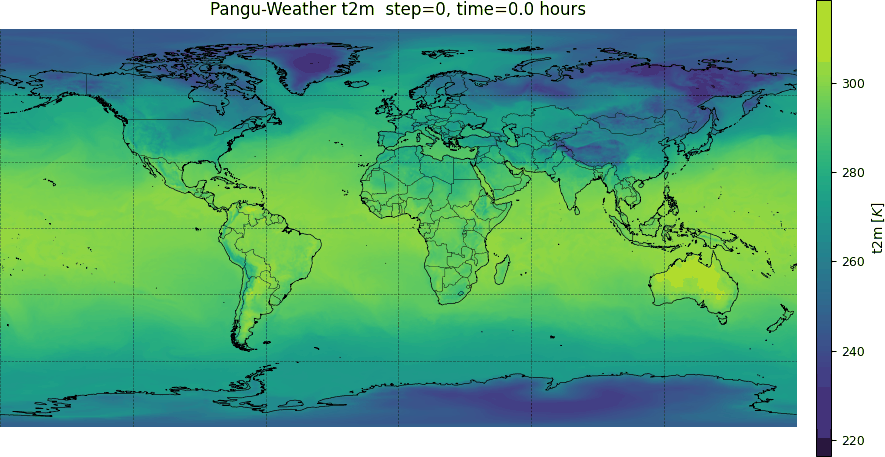
Figure 4: Temperature (K) at height of 2m above the earth’s surface as predicted for \(10\ \rm{days}\) using the Pangu-Weather model with starting date of 01/01/2024.
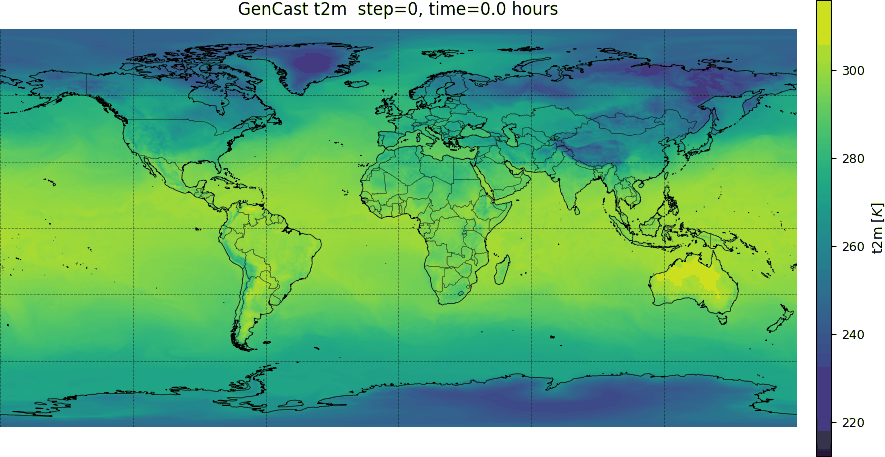
Figure 5: Temperature (K) at height of 2m above the earth’s surface as predicted for \(10\ \rm{days}\) using the GenCast model with starting date of 01/01/2024.
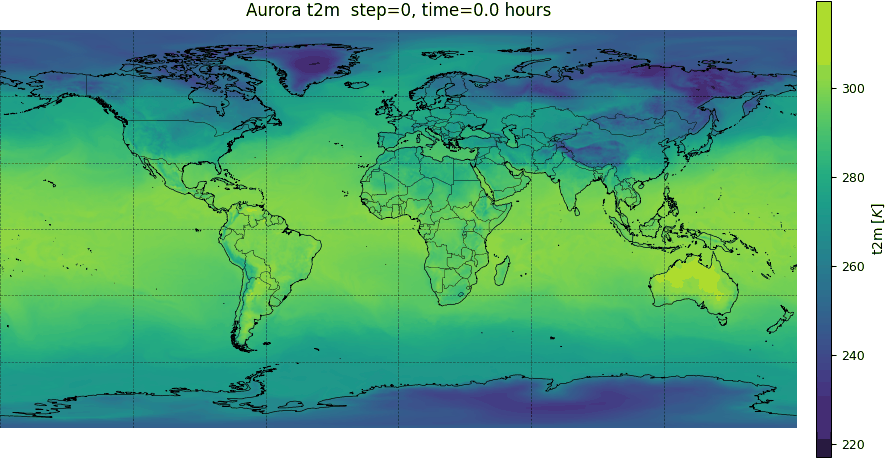
Figure 6: Temperature (K) at height of 2m above the earth’s surface as predicted for \(10\ \rm{days}\) using the Aurora model with starting date of 01/01/2024.
Adapting for AMD Hardware#
In order to run these on AMD MI300X, the key requirement was the use of software library versions compatible with ROCm. As we mentioned before, there are different ways to do this as described in the ROCm software page. The recommended way, which we adopted was to use a prebuilt Docker image. After that, the only changes that we required were applying the patch for ONNX on Pangu-Weather, because the code did not provide a ROCm compatible provider (only a CPU provider and a CUDA provider). While these changes were enough to run all of the software, we did specify some XLA parameters to ensure that the software used the minimum memory footprint possible, but it would still run without setting the XLA parameters.
Summary#
In this blog post we have demonstrated how to run a number of state-of-the-art AI weather forecasting models on the AMD MI300X GPU. While we have only tested the models on this particular GPU, the models themselves are small and could likely be satisfactorily run on less performant hardware as well. Getting the models to run on the MI300X was very straightforward and required minimal fixes. We then looked at the outputs of the three models and visually examined the predictions of a couple of the variables over a ten-day forecast. The code used to do this is available at our repository.
Acknowledgements#
In this post, we use software and data contributed by several research groups. We gratefully acknowledge the following:
ECMWF Lab for the ai-models framework, which provides unified interfaces for running AI based weather models.
Pangu-Weather by Huawei, accessible via GitHub and described in their publication: A 3D High-Resolution Model for Fast and Accurate Global Weather Forecast [1].
Aurora by Microsoft, available at GitHub and detailed in the paper: A Foundation Model for the Earth System.
GraphCast by Google DeepMind, with resources available at GitHub and in the paper GenCast: Diffusion-based ensemble forecasting for medium-range weather.
Copernicus Climate Data Store (CDS) for providing high-quality reanalysis data and APIs, accessible through the CDS Datasets portal and the CDS API.
We thank these teams and platforms for their open access to models, data, and tools that make AI-based weather prediction research and applications more accessible and reproducible.
References#
[1] Soci, C., Hersbach, H., Simmons, A., Poli, P., Bell, B., Berrisford, P., et al. (2024) The ERA5 global reanalysis from 1940 to 2022. Quarterly Journal of the Royal Meteorological Society, 150(764), 4014–4048. Available from: https://doi.org/10.1002/qj.4803
[2] Bi, K., Xie, L., Zhang, H. et al. Accurate medium-range global weather forecasting with 3D neural networks. Nature 619, 533–538 (2023). https://doi.org/10.1038/s41586-023-06185-3
[3] Price, I., Sanchez-Gonzalez, A., Alet, F. et al. Probabilistic weather forecasting with machine learning. Nature 637, 84–90 (2025). https://doi.org/10.1038/s41586-024-08252-9
[4] Bodnar, C., Bruinsma, W.P., Lucic, A. et al. A foundation model for the Earth system. Nature 641, 1180–1187 (2025). https://doi.org/10.1038/s41586-025-09005-y
Disclaimers#
Third-party content is licensed to you directly by the third party that owns the content and is not licensed to you by AMD. ALL LINKED THIRD-PARTY CONTENT IS PROVIDED “AS IS” WITHOUT A WARRANTY OF ANY KIND. USE OF SUCH THIRD-PARTY CONTENT IS DONE AT YOUR SOLE DISCRETION AND UNDER NO CIRCUMSTANCES WILL AMD BE LIABLE TO YOU FOR ANY THIRD-PARTY CONTENT. YOU FOR ANY THIRD-PARTY CONTENT.